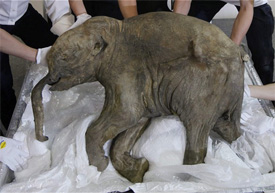Scientists have unearthed what they believe are the fossils of the world’s smallest known dwarf mammoth that stood about one meter high at the shoulders and roamed the Greek island of Crete thousands of years ago. The findings, published in the journal Proceedings of the Royal Society B, could help yield insights as to how giant animals can shrink to tiny sizes over evolutionary time, the scientists said. According to them, dwarfism often happens to species of large animals when they get trapped on islands, including dinosaurs. This helps giants survive within the limits imposed by islands, they said.
“There’s a big question regarding these elephants — how can something so big become dwarfs so small?” study researcher Victoria Herridge, a vertebrate paleontologist at the Natural History Museum in London, was quoted as saying by LiveScience. To learn more, Herridge and her colleagues analyszed dwarf fossils first discovered in Crete (an island some say was the birthplace of the Greek god Zeus) more than a century ago. Paleontologists have long argued whether the remains belonged to curvy-tusked mammoths or straighter-tusked elephants.
Teeth discovered more recently in the same area in Crete now suggest the animal was in fact a mammoth, Mammuthus creticus. A newfound foreleg bone suggests it was the smallest mammoth known, standing only about 3 feet 8 inches high at the shoulders and weighing only approximately 310 kg, making it about the size of a modern baby African or Asian elephant. These dwarf mammoths were not woolly mammoths. “When most people think of mammoths, they think of woolly mammoths,” said Herridge. “We think this dwarf was more adapted to warmer environments, more in appearance like modern African or Asian elephants, with a sparse covering of hair, although they would have had curvy tusks like all mammoths.”
Mammuthus creticusis the first evidence for extreme island dwarfism in mammoths. It would have been comparable in size to the smallest dwarf elephant known, the extinct species Palaeoloxodon falconeri from Sicily and Malta, which stood only about 3 feet 5 inches (1.04 m) high at the shoulder and weighed only approximately 238 kg.
The fossils suggest this dwarf mammoth was descended from one of the first mammoth species to arrive in Europe from Africa, Mammuthus rumanus or Mammuthus meridionalis. As such, the researchers suggest dwarf mammoths may have evolved much earlier than previously thought — as far back as 3.5 million years ago.
“Now that we know what this dwarf species might have been descended from, we can ask bigger questions, such as how and why and how fast dwarfism happened here,” Herridge said. Given the scant fossils and the uncertainty about Crete’s environment during this period, not much is known about how this dwarf might have lived. Still, its teeth do suggest it browsed on shrubs as opposed to grass like woolly mammoths.



 May 13th, 2012
May 13th, 2012  riffin
riffin 
 Posted in
Posted in 